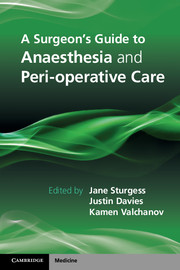Book contents
- Frontmatter
- Contents
- List of contributors
- Foreword
- Section I Basic sciences
- Chapter 1 General physiology
- Chapter 2 System-specific physiology
- Chapter 3 Pain and analgesia
- Chapter 4 Local anaesthetics
- Chapter 5 Sedation
- Chapter 6 Physics and measurement
- Section II Anaesthesia and peri-operative care for surgical specialties
- Section III At a glance
- List of abbreviations
- Index
Chapter 3 - Pain and analgesia
Published online by Cambridge University Press: 05 July 2014
- Frontmatter
- Contents
- List of contributors
- Foreword
- Section I Basic sciences
- Chapter 1 General physiology
- Chapter 2 System-specific physiology
- Chapter 3 Pain and analgesia
- Chapter 4 Local anaesthetics
- Chapter 5 Sedation
- Chapter 6 Physics and measurement
- Section II Anaesthesia and peri-operative care for surgical specialties
- Section III At a glance
- List of abbreviations
- Index
Summary
‘Pain insists upon being attended to. God whispers to us in our pleasures, speaks in our consciences, but shouts in our pains. It is his megaphone to rouse a deaf world.’
– C. S. Lewis.Introduction
Pain is an unpleasant sensation to a noxious stimulus, a stressor that can threaten the individual’s homeostatic state. The physiological and behavioural adaptive responses to this stress have evolved to preserve life. However, the persistence of this stress response with its concomitant over-stimulation of the sympathetic nervous system, energy depletion and the anomalous hormonal imbalance may be life-threatening.
Effective pain control is an essential component of high-quality care of the surgical patient. Despite advances in the knowledge of pathophysiology, pharmacology, and techniques of post-operative pain control, numerous surgical procedures take place every year where patients continue to experience unnecessary discomfort.
Pain! The fifth vital sign
As the fifth vital sign pain should be measured as frequently as other vital signs visible at the end of the bed. It should be recorded on the standard observation chart, and algorithms should be in place to set thresholds for intervention. Pain that becomes uncontrolled can alert the physician to a change in the pathology or progression of the underlying condition.
This chapter will cover: the transference of the pain signal (transduction, transmission, perception and modulation); the analgesic response (stress release of pro-opiomelanocortin cleaved into ACTH (adreno-corticotrophic hormone), and encephalins); the reflex escape response (the sympathetic nervous system and neuroendocrine system); and the effects of physiological changes.
- Type
- Chapter
- Information
- A Surgeon's Guide to Anaesthesia and Peri-operative Care , pp. 35 - 47Publisher: Cambridge University PressPrint publication year: 2014

